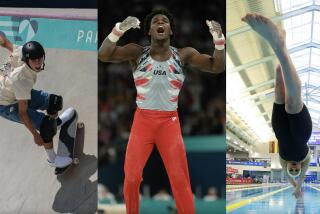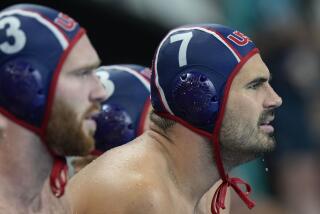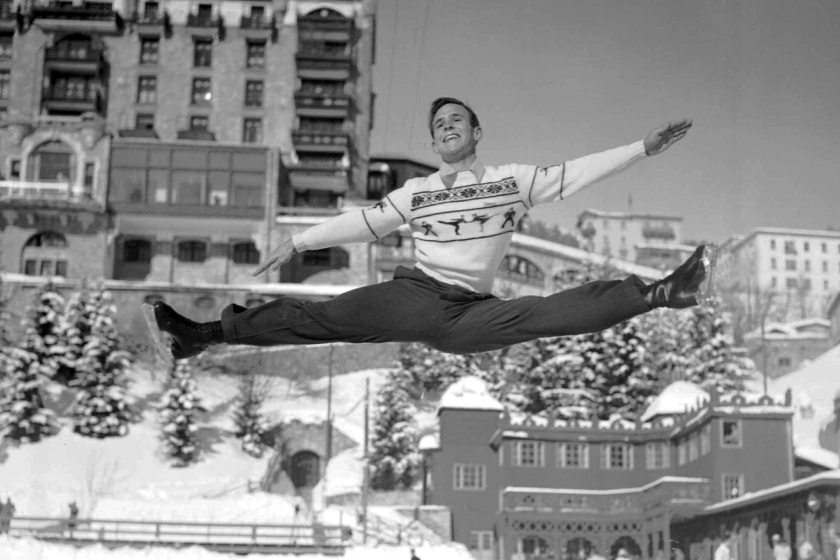717 Days and Counting : The Next Winter Olympics Are Only Two Years Away
- Share via
ALBERTVILLE, France — There are only 717 more training days for U.S. athletes until the opening ceremony of the 1994 Winter Olympics at Lillehammer, Norway.
In 1986, the International Olympic Committee voted for various reasons, including the prospect of greater television revenues, to change the cycle of future Winter Games so that they would not fall in the same year as the Summer Games.
Lillehammer’s Games will be the first of the new cycle, motivating the U.S. Olympic Committee to establish a $2-million program known as “Team ‘94” to meet the special funding needs of the U.S. sports that will be preparing athletes during the next two years.
USOC officials said they are optimistic that many of the athletes who competed in the 1992 Winter Olympics will remain in competition through the 1994 Games. “We want to keep the momentum going,” USOC President William Hybl said.
An early sport-by-sport look at U.S. prospects for 1994:
FIGURE SKATING
After placing three among the top four in the women’s individual competition and two among the top four in the men’s, the United States won’t have an easy time duplicating their 1992 performance in ’94.
But it’s possible, particularly in women’s singles if gold medalist Kristi Yamaguchi, 20; bronze medalist Nancy Kerrigan, 22, and fourth-place Tonya Harding, 21, decide to return. “I think at least two of the three will be back,” said USOC secretary Chuck Foster, a former U.S. Figure Skating Assn. official.
Even if they’re not, the United States has three teen-agers--Lisa Ervin, Nicole Bobek and Tisha Walker--who might be ready to contend by 1994. The United States is so deep in women’s figure skating that its first six from the national championships could have finished among the top seven here.
Among the men, silver medalist Paul Wylie and fourth-place finisher Christopher Bowman have decided to retire, but two-time U.S. champion Todd Eldredge, 20, a former bronze medalist in the World Championships who finished 10th in France because of a back injury, figures to regain his status among the contenders. Mark Mitchell, third in the U.S. championships this year, also figures to be well-liked by international judges when he finally has a chance to skate in front of them.
Of the pairs teams, Jenni Meno, 21, and Scott Wendland, 26, seem to have the most promising futures, even though they finished 11th here. There are doubts about whether the other pairs teams here, sixth-place Natasha Kuchiki and Todd Sand and ninth-place Calla Urbanski and Rocky Marval, will still be competing together in 1994.
The dance team with the most potential, Elizabeth Punsalan, 21, and Jerod Swallow, 25, was left home because they finished third in the national championships, but they probably would have finished in the top 10 here, something neither U.S. team here did, because of their creativity.
ALPINE SKIING
After winning two silver medals, the U.S. women’s Alpine team looks forward to 1994 with justifiable confidence. The men’s division is about where the women were two or three seasons ago, with one or two stars and then a big drop-off in ability, but there’s also light at the end of their two-year tunnel to Lillehammer.
Overall, of the 25 top skiers, only three will be over 26 when the 1994 Winter Games begin--one man, Jeff Olson, who will be 28, and two women, Eva Twardokens and Edith Thys, 28 and 27, respectively. Twardokens has not said whether she will return, but U.S. women’s Coach Paul Major said: “I sure hope she does.”
Twardokens finished seventh in the giant slalom and eighth in the super-G.
Others to watch, with their ages in ‘94, will be Diann Roffe, 26, co-silver medalist in the giant slalom; Hilary Lindh, 24, silver medalist in the downhill; Julie Parisien, 22, fourth in the slalom and fifth in the giant slalom, and Krista Schmidinger, 23, 11th in the Alpine combined and 12th in the downhill.
Kristi Terzian, who was unable to recover fast enough from a knee injury to compete this time, will be 26 and could add even more depth to the slalom/giant slalom group, and Kristin Krone, who would have raced in the downhill here if she hadn’t broken her left hand in training, will be 25.
Concludes Major: “We’re light-years ahead of where we were at Calgary in 1988.”
The men are probably only years ahead, but as Twardokens said: “They’re young and talented. We (the women) were down like they are, and we pulled ourselves up. They’ll do the same.”
Pulling the hardest will be AJ Kitt, who may find the Norwegian downhill course to be a traditional one, more to his liking. Kitt, who finished ninth on Val d’Isere’s Bellevarde track, will be 25 at Lillehammer, prime time for downhillers.
Olson, who has not disclosed his racing plans, was 13th in the super-G, and Matt Grosjean, who will be 23 in ‘94, looks like a star on the rise after his 10th place in the slalom.
HOCKEY
Although few members of the fourth-place U.S. team are expected to return in 1994, prospects are bright for the team that will play in Lillehammer.
Art Berglund, director of player personnel for the Olympic team, said it’s difficult to predict who might return because most players on the 1992 team will go on to professional careers, and only one or two might be permitted to leave their clubs. However, he didn’t expect to have Greg Brown and Guy Gosselin this time after making their Olympic debuts in 1988, so anything is possible.
“Nobody’s committed yet, but I’m sure a player like Mike Dunham or a Ted Drury, those guys are pretty committed to going back to school and could be back with us,” Berglund said. “Overall, things look really good. We had 80 candidates for this team come out at the (U.S. Olympic) Festival, and only nine guys from there ended up on the team. So, we know we’ve got a lot of fine prospects.
“The fact that we (finished fourth) will help bring other players out. We think we’ve got a real good talent pool. Preparations are already underway for ‘94: we’ve got some identification programs going. And obviously, the success of this team makes kids want to have that experience themselves.”
Among the candidates for the team at Lillehammer are twins Chris and Peter Ferraro and defenseman Pat Peake of Detroit, the Washington Capitals’ first pick and 14th overall in 1991 NHL draft, and center Brian Rolston of Flint, Mich., the New Jersey Devils’ second pick in the 1991 draft.
LUGE
The United States looks as if it has some a chance to win a medal in both the men’s and women’s singles in Lillehammer. The likely candidates are going to be the same ones who failed to get it done on the icy, 19-turn elevated track at La Plagne--Duncan Kennedy and Cammy Myler.
Kennedy, the 24-year-old from Lake Placid with the burr haircut and the U.S. Luge tattoo on his biceps, stood out more for his appearance than his luge at La Plagne, where he finished 10th.
Kennedy figured to do a lot better than that, especially in view of his results on the World Cup circuit--five medals in six races and second place in the final overall standings. Instead, he had a slow time on the first of his four runs and never recovered.
Chances are that with two more years of experience, Kennedy could be reaching his luge prime, but gold-medal winner Georg Hackl of Germany is only 15 months months older and has already won the world championship twice.
Someone to keep an eye on is Rob Pipkins, an 18-year-old from Staten Island who came virtually out of nowhere to win the World Junior Championship, wound up on the U.S. team and finished 21st at La Plagne.
Myler is all but alone among the U.S. women who could challenge for a medal in 1994. The 23-year-old Dartmouth College premed major had flu and wound up fifth.
BOBSLED
As they ride down the bobsled track, the only way to go is up for the U.S. two-man and four-man teams.
Four years after getting nosed out of a bronze medal by .02 seconds at Calgary, the top U.S. four-man sled finished ninth at La Plagne.
Before Lillehammer, the U.S. Bobsled and Skeleton Federation appears to be searching for only two things:
1) Team members.
2) Faster times.
Otherwise, the U.S. team looks to be in great shape.
At the center of the bobsled controversy is how professional athletes should be involved in the sport. Pro football star Herschel Walker, who made the team as a brakeman only to be dropped two days before the four-man event, said he is leaning toward coming back in 1994.
Coach John Philbin said drivers Brian Shimer, Randy Will, Brian Richardson and Chuck Lenowicz only need experience. Brakeman Chris Coleman, moved up to the top pusher job by Will after dumping Walker, helped USA I produce four starts of less than six seconds.
But Will was inconsistent, driving the sled to consecutive finishes of 10th, third, 10th and eighth. The U.S. team believes more technical help on the sleds, coupled with continued world-class start times, will put the sleds in position for a medal in 1994.
SPEEDSKATING
The United States sent what amounted to a one-woman team to Albertville in Bonnie Blair, who won two gold medals. No other U.S. speedskater, man or woman, won a medal, and no other woman finished among the top 10 in any of the five events.
Blair, 27, said she will make a decision this spring whether to begin training for 1994, but it’s not likely her coach, Peter Mueller, will allow her to quit without an argument.
“He’s already bought my plane ticket for Lillehammer,” said Blair, who sounds as if she is leaning toward an attempt to add to the four medals, including three golds, that she won in the 500 and 1,000 meters in Calgary four years ago and here.
Otherwise, the U.S. women seem to be on hold until the juniors who former gold medalist Dianne Holum is training in Milwaukee mature. They might be a better bet for Nagano, Japan, in 1998, when the United States will have indoor tracks at Milwaukee and Salt Lake City.
Ditto for the U.S. men, although Dan Jansen, 26, said that he is strongly considering returning. Unquestionably one of the world’s foremost sprinters, he has been frustrated in his attempt to win medals during the last two Winter Games. His best finish here was a fourth in the 500. Eric Flaim, 24, who won a silver medal and had three fourth-place finishes at Calgary, finished no higher than sixth here and announced his retirement.
NORDIC EVENTS
As often as U.S. competitors and coaches said they were encouraged by performances here, that there is real hope in the Nordic events--cross-country skiing and ski jumping--and the closely related biathlon, the evidence is to the contrary.
The simple fact is that U.S. athletes--men and women--were not in medal contention in any of the Nordic or biathlon events at Albertville. In most events, Americans were happy to get near the top 10.
Nor is there a vast pool of young athletes coming up to replace those who made these Games their last. The top male hope in cross-country is John Aalberg, a native Norwegian who became a U.S. citizen in January. He, though, will be 33 in 1994. And although retread Bill Koch--whose cross-country silver medal in 1976 still ranks as the upset of the century in the Nordic events--insists that he will be back in shape to ski for a medal at Lillehammer, he might be kidding himself. He will be 38.
There were great hopes here for Ryan Heckman, 17, as a ski jumper. He competed only in Nordic combined, though--jumping and cross-country racing in one event--skipping the individual and team jumping events. As promising as he is as a jumper, he is considerably less so as a cross-country skier. And even as a promising young jumper, he is not quite as impressive as two other young jumpers, 16-year-old Toni Nieminen of Finland and 17-year-old Martin Hollwarth of Austria, both of whom won multiple medals in France.
The real problem with the Nordic sports, though, is not so much the athletes as the sports themselves. They are so obscure, by American standards, and offer so little in terms of fame and fortune that they draw only those few athletes who compete because they find the sports fun, challenging or both. Josh Thompson, the country’s leading biathlete, describes himself as an amateur pursuing his hobby. Sponsorships are practically nonexistent.
Simply put, unless America as a country suddenly decides that ski jumping, cross-country sking and the biathlon are sports it can’t live without, the best athletes are going to find other sports in which to apply their talents. And the United States will always be looking for some way to catch up in the Nordic events.
More to Read
Go beyond the scoreboard
Get the latest on L.A.'s teams in the daily Sports Report newsletter.
You may occasionally receive promotional content from the Los Angeles Times.







